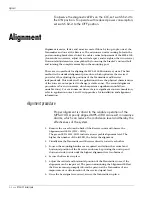
MPS-4100 product guide • • • a - 1
a
Application notes
Do’s and Don’ts a planning primer
Introduction
The purpose of this Application Note is to outline the “rules” for bistatic
microwaves, to allow for the successful installation and operation of microwave
units.
Bistatic microwave sensors have been used in security applications for many
years. They operate successfully, as long as the rules for bistatic microwaves are
understood and followed. These rules include limitations in site coverage and
detection capability, as well as the critical need for proper site preparation.
Improper site preparation will result in nuisance alarms and inconsistent
detection.
Microwave basics
A transmitter sends out an electromagnetic wave in the microwave band toward a
receiver. The receiver picks up an electromagnetic signal composed of both the
direct signal from the transmitter and the reflected signal from the ground and
other nearby objects. Any metallic or water-containing (living) conductive object
moving within the microwave field alters the received signal in amplitude and
phase. The changes in the received signal are analyzed, and if they meet the
criteria for object size and speed, an intrusion alarm is declared.
Microwave detection zone size
The size of the microwave detection zone varies greatly between the transmitter
and the receiver. The detection coverage is very small near either unit, typically
15 cm (6 in.) in diameter. Therefore, the areas directly below the transmitter and
receiver are unprotected, as indicated in Figure a-1. Microwave units MUST be
offset to provide complete coverage of these unprotected areas, as indicated in
Figure a-2, Figure a-3 and Figure a-4.
















































